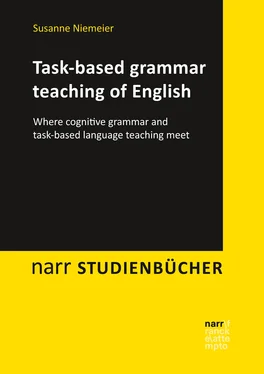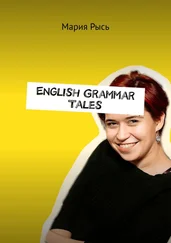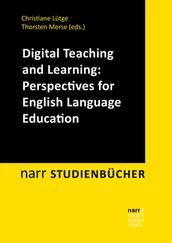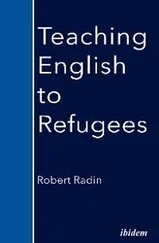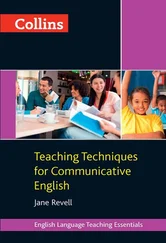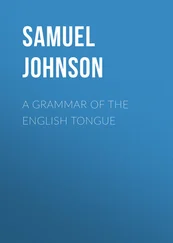1 ...7 8 9 11 12 13 ...23 In this way, the learners already see the plural – s in use and may deduce that its use is bound to a higher quantity than 1. The worksheet could furthermore contain illustrations showing signs at a market stand which mention ‘fresh carrots’, ‘delicious grapefruits’ or the like. The learners are then expected to fill six to ten lines with the quantity and the type of fruits they need to buy in order to make their favourite fruit salad. To motivate them even further, the last item on the shopping list could be called a ‘secret ingredient’, where the groups can use their imagination and add ants, spiders2, marshmallows or whatever tickles their fancy. This usually heightens the learners’ motivation, they will enjoy the task and possibly have strong reactions, which make them remember the grammatical structure in their future language use. If the learners are furthermore told that after the reports the class is going to take a vote on the best fruit salad, they will try to excel.
While the learners are working on the task the teacher should stay in the background as much as possible. Although it may be tempting for teachers to go from group to group (or pair to pair) and offer advice and help, they should only intervene when problems occur, for example, when the groups or pairs do not speak in English but in their native language or when a group or pair is completely stuck and asks the teacher for help. In learner-learner interaction, linguistic risk-taking behaviour is more likely to appear, due to the fact that the learners are peers. If the teacher controlled them, they would most certainly speak less and presumably only use language of which they are sure that it is correct. This can result in non-fluent communication and the new structure might not be used at all, because in such a situation the learners would act as language learners and not as language users. In an ideal case, the teacher just monitors from a distance and keeps track of the time. Some minutes before the time allowed for the task is over, the teacher should announce that the groups/pairs need to come to an end soon.
During the following planning phase for the report the learners need to work on the language that they will use for the report. Normally, the report is an oral report (although it may involve graphs, drawings, posters etc., but even these still have to be described orally) and every group member should say at least one sentence, as each of the group members is accountable for the group result. Therefore, the learners have to decide who says what and they then formulate their utterances together. They may ask the teacher for help with their formulations, but new vocabulary should only be introduced if it is easy to explain to the other classmates, who obviously need to be able to understand the others’ reports. The planning time for the report is important and should not be left out or shortened drastically. As R. ELLIS (2003: 137) states, “when there is opportunity for planning, accuracy is enhanced, a finding that is perhaps best explained in terms of learners’ use of explicit knowledge to monitor their performance”. As the planning is done in groups (or in pairs), the learners can negotiate the form and the meaning of their utterances and can pool their knowledge, helping each other out. In this way, learner-learner interaction can contribute to the learning effects of the task, as the learners have the opportunity to profit from as well as learn from each other’s world knowledge and linguistic knowledge.
The teacher’s role changes again during the report, as s/he becomes a moderator, calling on the groups/pairs, keeping track of the time frame, evaluating what the learners say and making sure that the rest of the class understands the reports. The teacher should also, either on a piece of paper or directly on the board, note down sentences that are to be used during the last task cycle phase, the language focus. If learners make mistakes during their presentations, these should be corrected implicitly in a non-intrusive way, for example, by a request for clarification or by repeating a sentence correctly. The report is a phase that should never be omitted as the learners want to present their task outcomes or products and as they need feedback.
If the time does not suffice to let all groups or pairs present, the left-over groups or pairs should be asked to hand in their reports so that they can get feedback as well. When the task was done in pair work, there is hardly ever enough time to let all pairs present. During the report phase, the teacher might want to call on pairs who have interesting results or solutions, which s/he will have noticed in the planning stage. When the task was done in group work, and provided that there is enough time for all groups to participate in the report phase, it is sometimes a good idea to have an election of the best result. Referring to the example given above, this could relate to the best fruit salad, which can then, for instance, be prepared for a future class breakfast. If the groups are not allowed to vote for their own salads, it is normally possible to reach a majority vote for one of the salads.
In WILLIS’ framework, the task cycle ends with what she calls a ‘language focus’, separated into ‘analysis’ and ‘practice’. The analysis phase is supposed to focus on specific features of the task texts, whereas the practice phase is meant for practising new words, phrases and patterns. According to WILLIS/WILLIS (2007: 114), the language focus takes place “outside the context of a communicative activity”. Although this is the stage where newly introduced grammatical phenomena could be presented in a structured way, WILLIS does apparently not intend to use this part of the lesson as a systematic restructuring phase but instead suggests to practice vocabulary and phrases used during the lesson, to do pronunciation exercises and to work on problems which came up during the lesson. These ways of using the language focus are quite haphazard and unsystematic and transform the language focus into a mere appendix to the lesson, because it is not really connected to it, is furthermore uncommunicative and can probably also be regarded as superfluous if time problems arise.
The perspective on task-based language teaching taken by this book suggests instead that the language focus be re-evaluated and should become a very important part of the lesson, not just an optional add-on and, crucially, that it stays within the context of the communicative topic of the lesson, because the example sentences come from the students’ own reports on their task outcomes. In the language focus, the learners’ attention is explicitly drawn to the grammatical phenomenon in question and to how it works communicatively, i.e., both form and meaning are focused upon. Implicitly, the grammatical phenomenon in question has already been used during the pre-task (by the teacher) as well as during the task (by the learners) and the language focus then moves from the learners’ implicit exposure to the grammatical construction towards raising their explicit awareness of the newly introduced structure.
Grammar teaching cannot be effective when it is isolated from a meaningful usage context, the latter having been provided by the task. To help the learners to notice the structure, their own sentences or utterances from the reports can be taken as an illustration of the grammatical phenomenon in question, as the learners already made use of it during the task and during their reports. In the language focus, the phenomenon can then finally be structured and explained. This is preferably done in an inductive way, meaning that the learners themselves try to find out the meaning and form of the structure, which allows for deeper cognitive processing1.
Читать дальше
